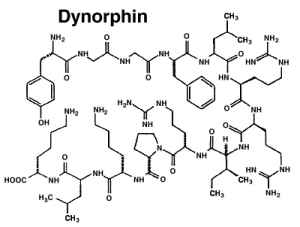

MedFriendly®


Dynorphin
Dynorphin is a very powerful group of endogenous
(meaning that is made inside the body) opioid ligand
(pleasure producing molecule/substance). Dynorphin
works by stimulating receptors specially designed for
opioids, much like how a key fits into a lock. In this
case, the dynorphin molecule (ligand) is the key and the
receptor is the lock. Dynorphin is widely distributed in
the human body. It is composed of 17 amino acid
residues (the remains of a certain type of organic
chemicals). Amino acids are a group of chemical
substances that form proteins.
Dynorphin's chemical structure.
FEATURED BOOK: Opiate Addiction:The Painkiller Addiction Epidemic
Dynorphin contains a pleasure producing substance known as leu5-enkephalin as the end
part of this molecule. The end part of this molecule is technically known as the NH2
terminal (end) sequence. Dynorphin is created by a precursor protein known as
prodynorphin. There are different types of dynorphin such as dynorphin A, dynorphin B,
and big dynorphin. Dynorphin is found in high amounts in the spinal cord, which is one
area it is made. An example is the back part of the spinal cord known as the posterior
horn. Dynorphin is also found widely throughout the brain but mostly in the brainstem and
hypothalamus. The brainstem is an area in the lower part of the brain that connects it with
the spinal cord. The hypothalamus is an area within the brain that is important for many
bodily functions such as sleep, appetite, and temperature control. The hypothalamus also
produces dynorphin as does the hippocampus. The hippocampus is a structure in the
lower part of the brain that is important for memory.
"Where Medical Information is Easy to Understand"™
In addition to reducing pain, dynorphin is known to affect the control
of appetite, helps regulate body temperatures, and maintains
circadian rhythms. Circadian rhythms are internally controlled
biological processes over a 24-hour period.
Dynorphin comes from the Greek word, "dynamis," meaning
"protein." The word "orphin" is short for "morphine," which is a
powerful substance that alleviates pain and causes pleasure.
Morphine comes from Morpheus (no, not the cool guy from The
Matrix), but the God of sleep and dreams. So put the root words
together and you have a "protein that is like morphine."















